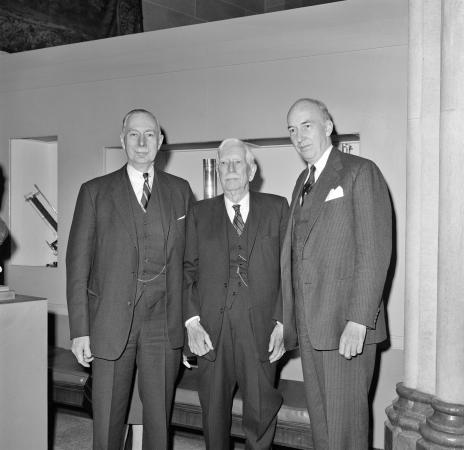Who gets installed as Secretary?
When Lonnie G. Bunch III was installed as Secretary of the Smithsonian Institution, he officially became the fourteenth person in our 173-year history to take on that responsibility. He is also the first historian (I’m very pleased, but I’m biased) and the first African American to be Secretary. But his historic appointment is also a return to tradition, as he was selected from within the Smithsonian like the first six Secretaries. Joseph Henry, Spencer Fullerton Baird, Samuel Pierpont Langley, Charles Doolittle Walcott, Charles Greeley Abbot, and Alexander Wetmore, who led the institution from 1846 to 1952, had each worked at the Smithsonian prior to becoming Secretary. The first Secretary from the outside was seventh Secretary Leonard Carmichael (1952–1964), who had been president of Tufts University. Though eighth Secretary S. Dillon Ripley (1964–1984) had been curator of birds at the Natural History Museum in the 1940s, the following five Secretaries were selected from outside of the Smithsonian. Robert McCormick Adams, I. Michael Heyman, Lawrence M. Small, G. Wayne Clough, and David K. Skorton, who led the Smithsonian from 1984 to 2019, were all new to the Smithsonian, although Heyman had been on the Board of Regents. Bunch assumes the role of Secretary with immense support from the Smithsonian after serving in many roles, including as the founding director of the National Museum of African American History and Culture.
What kind of ceremonies marked their installation as Secretary?
The first four, Henry, Baird, Langley, and Walcott, died in office, so, out of necessity, a new Secretary was quickly selected, without the pomp and circumstance we know today. Abbot was the first to retire in 1944—and it was a good thing since he had a very long life (1872-1973)! For the first time, a Secretary announced his decision to retire, and the Regents were able to conduct a search for a new leader.

When the first formal installation did take place in 1952, Carmichael was sworn in by the Board of Regents, taking the oath of office used by heads of federal agencies. Later research determined this was not legally appropriate since he was not a federal employee. In the afternoon, staff, which numbered far fewer than today, were invited to meet the new boss at a Castle reception. The transition from Carmichael to Ripley in 1964 was publicly celebrated at the opening of the National Museum of American History. The Regents swore him in at a meeting, and the staff welcomed him back at a reception in the Castle. Since it had been determined that taking an oath was inappropriate, a new tradition began when Chief Justice Earl Warren handed Ripley a ceremonial key to the Castle.

What do more modern installations look like?
The ceremonies for successive Secretaries have been larger and far more public. Adams’ installation in 1984 consisted of a Regents’ swearing in and then a “simple, dignified ceremony at 12-12:30pm in front of Joseph Henry Statue” on the north side of the Castle. All in the Smithsonian family were invited. The U.S. Navy Ceremonial Band played, and Chief Justice Burger transferred the Castle key to Adams. Chief Justice Rehnquist presided over similar ceremonies for Heyman and Small, including transferring the Castle key, music by a military band, a rendition of the national anthem, and the presentation of the colors by the Joint Armed Forces Color guard.

Shortly after President Barrack Obama’s first inauguration, Clough’s installation was held in the National Museum of the American Indian, presided over by Chief Justice John Roberts. It included, for the first time, an academic procession, the national anthem, sung by a very gifted staff member, and music by the Smithsonian Chamber Players. Roberts presented Clough with the Castle key, Smithsonian mace, and the Badge of Office. Skorton’s installation was similar but highlighted the newly renovated Arts and Industries Building and the music program left previous ceremonies in the dust. Skorton is a jazz flautist, as well as a medical doctor and administrator. A friend of his, Wynton Marsalis, played Louis Armstrong’s trumpet from the National Museum of American History’s collection, accompanied by the Smithsonian Jazz Masterworks Orchestra. The performance not only added flare to the ceremony, but it also gave Smithsonian employees insight into the interests of their new Secretary.

On November 1, 2019, Secretary Lonnie G. Bunch III was officially installed as the leader of the Smithsonian. In a speech, he recognized darker episodes in Smithsonian's past, such as when Secretary Joseph Henry forbade Frederick Douglass from speaking at the Castle, but rather than feel the burden of history, he spoke of optimism and promise. Congratulations, Secretary Bunch!
Related Resources
- Secretaries of the Smithsonian Institution, Smithsonian Institution Archives
- Sneak Peek, Lonnie G. Bunch III
- Welcome Secretary Skorton!, by Lisa Fthenakis, The Bigger Picture, Smithsonian Institution Archives
Produced by the Smithsonian Institution Archives. For copyright questions, please see the Terms of Use.

Leave a Comment